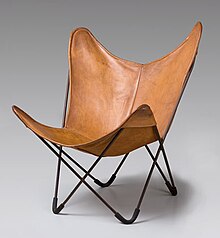Butterfly chair

The butterfly chair, also known as a BKF chair or Hardoy chair, is a style of chair featuring a metal frame and a large sling hung from the frame's highest points, creating a suspended seat. The frame of the chair is generally painted black. The sling was originally leather,[1] but can also be made from canvas or other materials. The design is popular for portable recreational seating.
History[]
The Butterfly chair was designed in Buenos Aires, Argentina in 1938 by the architects Antonio Bonet, Juan Kurchan and ,[2][3][4] who were working with Le Corbusier's studio, and who formed the architectural collective in Buenos Aires.[5] The chair was developed for an apartment building they designed in Buenos Aires.
On March 6, 1940, a picture of the chair appeared in the US publication Retailing Daily, where it was described as a "newly invented Argentine easy-chair . . . for siesta sitting".[1] On July 24, 1940, the chair as awarded 2nd prize by the National Cultural Commission [6] at the 3rd Salón de Artistas Decoradores exhibition in Argentina.[1] Both the exhibition and the picture in Retailing Daily attracted the attention of the Museum of Modern Art in New York. At the request of the director of MoMA's Industrial Design Department, Edgar Kaufmann Jr., Hardoy sent 3 chairs to New York. One went to Fallingwater, Edgar Kaufmann Jr.'s home in Pennsylvania (designed by Frank Lloyd Wright), another went to MoMA,[2] while the third probably went to Clifford Pascoe of Artek-Pascoe, Inc., New York.[7]
The chair gets the name of BKF chair from the initials of its creators "Bonet-Kurchan-Ferrari". It is also known as the Hardoy chair because an official letter from the firm attributed primary authorship of the design to Ferrari-Hardoy[citation needed].
Origins[]
The BKF chair is a modern update of the Paragon chair (more recently known as the Tripolina chair), which was designed by Joseph Beverley Fenby and has been used as campaign furniture and camping furniture since the 1880s.
Production[]
The chair was originally designed in Argentina.[8] However, Edgar Kaufmann Jr. accurately predicted that it would become extremely popular in the US, calling it one of the "best efforts of modern chair design".[9] In the early 1940s, it was produced in the US by Artek-Pascoe, Inc., New York[2]). Production was slow, due to wartime shortage of metal.[3] After the war, the US production rights were acquired by Hans Knoll, who had recognized its commercial potential in 1947[10] and added it to the Knoll line.[11]
The chair’s commercial success led to a surge in unauthorized replicas. After a losing a legal case for design-infringement, Knoll ceased production in 1951.
Since then, the butterfly chair continues to be produced by many manufacturers from many countries.
References[]
- ^ Jump up to: a b c Blake, Peter; McCullough, Jane Fiske (August 1958). "very significant CHAIR" (PDF). Harper's Magazine. p. 69. Archived from the original on 2014-07-18. Retrieved 2018-02-14. Alt URL
- ^ Jump up to: a b c "B.K.F. Chair 1938". Museum of Modern Art. Retrieved 2018-02-14.
- ^ Jump up to: a b Hiesinger, Kathryn B.; Marcus, George H. (1993). Landmarks of twentieth-century design : an illustrated handbook. New York: Abbeville Press. pp. 142. ISBN 1558592792. Retrieved 2018-02-14.
- ^ "B.K.F. Chair/Hardoy Chair, Butterfly Chair, 1938". Vitra Design Museum. Retrieved 2018-02-14.
- ^ "Grupo Austral". Vitra Design Museum. Retrieved 2018-02-14.
- ^ "Ferrari Hardoy, Jorge, 1914-1977. The Ferrari Hardoy Archive: An Inventory". Special Collections, Frances Loeb Library, Harvard Design School. Retrieved 2018-02-16.[permanent dead link]
- ^ "Ferrari Hardoy, Jorge, 1914-1977. The Ferrari Hardoy Archive: An Inventory". Special Collections, Frances Loeb Library, Harvard Design School. Retrieved 2018-02-16.[permanent dead link]
- ^ "Antonio Bonet, Juan Kurchan, Jorge Ferrari Hardoy. B.K.F. Chair. 1938 | MoMA". The Museum of Modern Art. Retrieved 2021-07-25.
- ^ "Ferrari Hardoy, Jorge, 1914-1977. The Ferrari Hardoy Archive: An Inventory". Special Collections, Frances Loeb Library, Harvard Design School. Retrieved 2018-02-16.[permanent dead link]
- ^ "Ferrari Hardoy, Jorge, 1914-1977. The Ferrari Hardoy Archive: An Inventory". Special Collections, Frances Loeb Library, Harvard Design School. Retrieved 2018-02-16.[permanent dead link]
- ^ Greenbaum, Hilary; Rubinstein, Dana (2012-03-09). "Who Made That Butterfly Chair?". The New York Times Magazine. Retrieved 2018-02-14.
- Chairs
- Individual models of furniture
- Portable furniture
- Argentine inventions